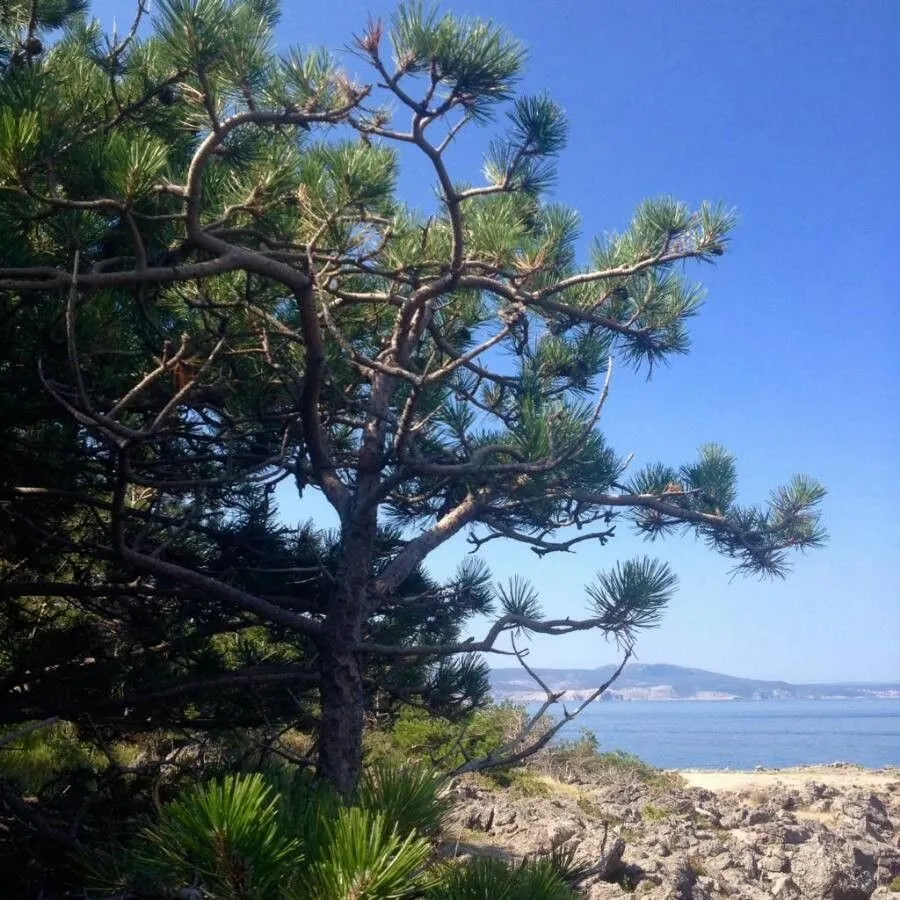
Author: Mill.
Bibliography: Gard. Dict. ed. 8.: n.° 10 (1768)
Year: 1768
Status: accepted
Rank: species
Genus: Pinus
Vegetable: Unknown
Observations: SE. Canada to E. U.S.A.
The Northern pitch pine, scientifically known as Pinus rigida, is a resilient and versatile tree native to Southeastern Canada and the Eastern United States. Described by Mill. in the 8th edition of Gard. Dict. (1768), this evergreen conifer belongs to the Pinaceae family, renowned for its hardiness and adaptability across a variety of environmental conditions.
Pinus rigida is typically characterized by its rugged appearance, featuring a thick, deeply furrowed bark that protects it against wildfires and harsh weather. The tree often has an irregular shape with twisted, gnarly branches that contribute to its robust nature. Reaching heights of 6 to 30 meters, Northern pitch pines display a remarkable ability to thrive in poor, sandy soils where other species might struggle.
The needles of Pinus rigida, grouped in bundles of three, are stiff and dark green, measuring about 6 to 13 centimeters in length. These foliage characteristics not only offer a picturesque view but also play a critical role in the tree’s survival by minimizing water loss and resisting damage from pests. The cones, generally about 3 to 7 centimeters long, are a distinctive feature as well, opening to release seeds following exposure to heat from forest fires, a process that ensures the regeneration of the species in its natural habitat.
Ecologically, the Northern pitch pine provides significant benefits to its environment. It forms an essential part of forest ecosystems, offering habitat and food to a variety of wildlife, from birds that nest in its branches to mammals that rely on its seeds. The tree’s ability to grow in less fertile soils also helps in preventing erosion, thereby stabilizing the landscape.
Culturally and historically, Pinus rigida has played a vital role. Its resin, historically known as “pitch,” was highly valued for waterproofing ships and other wooden structures, a testament to the tree’s importance in early industry and transportation.
Overall, the Northern pitch pine stands out not just for its striking physical characteristics but also for its ecological, cultural, and economic contributions. Its enduring presence from Southeastern Canada to the Eastern United States highlights its significant role in both natural and human-altered landscapes.
Dan: beg-fyr
Eng: hard pine, northern pitch pine, pitch pine, northern pitch-pine, torch pine
Deu: pech-kiefer, pechkiefer, wiesenkiefer
Nld: pekden, doornden
Fra: pin, pin dur, pin raide, pin rigide, pin à aubier, pin à feuilles rigides
Ita: pino pece, pino rigido
Hun: szurkosfenyo
Ces: borovice tuhá
Swe: styvbarrig tall
En: Northern pitch pine, Pitch pine, Hard Pine, Northern Pitch-pine, Torch pine
Ar: خشب العزيزي
Be: Хвоя цвёрдая
Zh: Gang song, 刚松
Cs: Borovice tuhá
Da: Beg-fyr
Nl: Doornden, Pekden
Et: Pigimänd
Fi: Pikimänty
Fr: Pin rigide, Pin, Pin dur, Pin raide, Pin à aubier, Pin à feuilles rigides
De: Pechkiefer, Pech-Kiefer, Wiesenkiefer, Steife Kiefer
Hu: Szurkosfenyo
Is: Bikfura
Io: Pichpino
It: Pino rigido, Pino pece
Ja: Rigida-matsu
Ko: Rigidasonamu, 리기다소나무
Lt: Šiurkščioji pušis
No: Bekfuru
Fa: کاج قیری
Pl: Sosna smołowa
Ru: Сосна жёсткая
Sk: Borovica tuhá
Sv: Styvbarrig tall
Zh-hant: 剛松
Taken Sep 12, 2020 by sarah vallée (cc-by-sa)
Taken Feb 1, 2020 by Dieter Wagner (cc-by-sa)
Taken Jul 12, 2018 by Richard Martinez (cc-by-sa)
Taken Feb 1, 2020 by Dieter Wagner (cc-by-sa)
Taken Oct 3, 2018 by Dieter Wagner (cc-by-sa)
© copyright of the Board of Trustees of the Royal Botanic Gardens, Kew.
© copyright of the Board of Trustees of the Royal Botanic Gardens, Kew.
Taken Nov 23, 2016 by Yoan MARTIN (cc-by-sa)
Taken Nov 23, 2016 by Yoan MARTIN (cc-by-sa)
Taken Jan 1, 1900 by EOL − Crusier (cc-by)
Taken Feb 1, 2020 by Dieter Wagner (cc-by-sa)
Taken Oct 3, 2018 by Dieter Wagner (cc-by-sa)
Taken Oct 3, 2018 by Dieter Wagner (cc-by-sa)
Taken Oct 3, 2018 by Dieter Wagner (cc-by-sa)
Taken Oct 3, 2018 by Dieter Wagner (cc-by-sa)
Taken Oct 3, 2018 by Dieter Wagner (cc-by-sa)
Taken Oct 3, 2018 by Dieter Wagner (cc-by-sa)
Taken Jun 10, 2019 by Jochen Kokemüller (cc-by-sa)
Taken Nov 23, 2016 by Yoan MARTIN (cc-by-sa)
Taken Aug 23, 2019 by bcarbo (cc-by-sa)
Taken Jan 13, 2018 by Rento (cc-by-sa)
Taken Feb 1, 2020 by Dieter Wagner (cc-by-sa)
Taken Jan 1, 1900 by EOL − USDA NRCS Wetland Science Institute. (public)
Taken May 6, 2017 by Tela Botanica − _ (cc-by-sa)
Taken Jan 1, 1900 by EOL − Dalgial (cc-by-sa)
Taken Jan 1, 1900 by EOL − Encyclopedia of Life (cc-by-nc)
Taken Mar 31, 2021 by garcia mata francisco (cc-by-sa)
Family: Myrtaceae Author: (F.Muell.) K.D.Hill & L.A.S.Johnson Bibliography: Telopea 6: 402 (1995) Year: 1995 Status:…
Family: Rubiaceae Author: Pierre ex A.Froehner Bibliography: Notizbl. Bot. Gart. Berlin-Dahlem 1: 237 (1897) Year:…
Family: Sapindaceae Author: Koidz. Bibliography: J. Coll. Sci. Imp. Univ. Tokyo 32(1): 38 (1911) Year:…
Family: Asteraceae Author: A.Gray Bibliography: Pacif. Railr. Rep.: 107 (1857) Year: 1857 Status: accepted Rank:…
Family: Fabaceae Author: Medik. Bibliography: Vorles. Churpfälz. Phys.-Ökon. Ges. 2: 398 (1787) Year: 1787 Status:…
Family: Aspleniaceae Author: (Cav.) Alston Bibliography: Bull. Misc. Inform. Kew 1932: 309 (1932) Year: 1932…